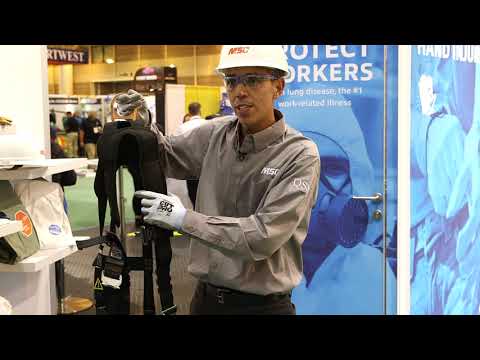Fall protection continues to hold the No. 1 spot on the OSHA Top 10 violations list—surpassing hazard communication violations by a margin of 40 percent. Here’s what else safety chiefs need to know.
When the U.S. government revealed its updated list of most-cited safety violations for fiscal 2019, there was good news in that total citations on its top 10 list had dropped 15 percent since the previous year.
What hasn’t changed is that fall protection continues to be a tough safety challenge.
For the ninth consecutive year, fall protection sits as the No. 1 most-violated standard, based on citations issued by the Occupational Safety and Health Administration during the past year—far outpacing violations for the other nine standards on the list and edging toward two-to-one over hazard communication at No. 2.
When it comes to fall protection in metalworking and manufacturing facilities, “commonsense often is not common,” says MSC Safety Specialist Damon Cassell.
How to Avoid 2019’s Top OSHA Violation: Fall Protection
To reduce fall incidents and violations, businesses need to adopt the zero-tolerance practices common within the gas and utility industry, Cassell recommends.
“If you’re dangerous, they will walk you right off the property,” he says.
The culprit is often the technical nature of both the fall safety gear itself and applying the OSHA standard’s rules, Cassell says. “In the safety world, if it’s difficult, people are a lot less likely to do it.”
For instance, depending on the environment, it’s not uncommon for a worker to have to run five or six calculations while scaling equipment on a plant floor.
Safety teams need to do a couple of things to make fall safety easier and more likely to be adopted, Cassell advises. First, simplify its use: Avoid multiple calculations whenever possible, and provide signage and training so workers can quickly determine required lanyard lengths.
“Make sure the fall distance is not shorter than your lanyard because you’re going to hit the ground. Also, make sure you tie off,” Cassell says. “I can’t tell you how many times I have seen people with all this gear on not tie off to the right lanyard or anchor.”
Safety culture is a factor here too. The harnesses and gear can be unwieldy to wear—particularly when a worker first becomes certified to use a harness, he points out.
Training and setting expectations can help overcome wear issues and encourage workers to never put themselves in harm’s way, Cassell says. “If you mess up, it’s likely you will die.”
Lockout/Tagout Violations Move Up on OSHA Top 10
Although the list OSHA released at the 2019 NSC Congress & Expo in San Diego included the exact same 10 standards as in 2018, there are a couple of items that safety chiefs should take note of and address, Cassell says.
First and foremost, the list is a “leading indicator,” a nationwide snapshot of what’s going on with safety practices generally, Cassell says. Safety managers should look to see how their shops fare by comparison and use the list to guide efforts to improve practices and safety culture overall.
As for additional takeaways, he points to the move up the list of lockout/tagout to No. 4.
“Lockout/tagout should never move up on the list,” Cassell says. “It should always move down. When something goes wrong in that situation, it’s always serious—losing limbs, dying immediately.”
Lockout/tagout swapped spots with respiratory protection, which dropped to No. 5 for the year. These were the only shifts in rankings on the list; all the other OSHA standards stayed at their same ranking.
It’s possible that new OSHA silica regulations, which took effect in June, led to increased focus on the proper and consistent use of respirators, leading to a bigger dip in citations than for lockout/tagout, Cassell says.
Even still, shops and factories need to focus on lockout/tagout, he advises: “In metalworking, the biggest concern is almost always lockout/tagout. No one is ever 100 percent compliant. You have to constantly be on it.”
The main reason safety teams must be vigilant about controlling hazardous energy sources is because of older equipment in use on shop floors big and small.
It’s possible to find quite old machines that work well but that are not compliant, Cassell says. “It’s why I always go to the back of the floor first. It’s where you find the big green machines—old cutters, old drills, old lathes.”
It’s easy to address most safety issues for these older machines, he says, using lockout/tagout kits to retrofit for compliance.
The Complete 2019 OSHA Top 10 List of Safety Violations and Tips to Stay Compliant
In all, the Top 10 list accounted for 26,915 violations cited by OSHA, compared to 31,816 for the same 10 standards the previous year. In each category, there were fewer citations this year than last.
Here’s a listing of each violation by ranking, with the number of citations this year and last, and also additional tips and tactics to help beef up your business’s compliance.
1. Fall Protection (1926.501)
Violations:
6,010 in 2019
7,270 in 2018
Safety Tips:
Video: 4 Ways to Stop Falls from Height
2. Hazard Communication (1910.1200)
Violations:
3,671 in 2019
4,552 in 2018
Safety Tips:
The Evolution of the Hazard Communication Standard
3. Scaffolding (1926.451)
Violations:
2,813 in 2019
3,336 in 2018
Safety Tips:
3 Tips for Preventing Falls from Height at Work
4. Lockout/Tagout (1910.147)
Violations:
2,606 in 2019
2,944 in 2018
Safety Tips:
Preventing Safety Hazards with Effective Lockout/Tagout Programs
5. Respiratory Protection (1910.134)
Violations:
2,450 in 2019
3,118 in 2018
Safety Tips:
Video: How to Fit-Test Respirators
6. Ladders (1926.1053)
Violations:
2,345 in 2019
2,812 in 2018
Safety Tips:
New Ladder Safety Rules
7. Powered Industrial Trucks (1910.178)
Violations:
2,093 in 2019
2,294 in 2018
Safety Tips:
Avoid 10 Major OSHA Violations
8. Fall Protection Training (1926.503)
Violations:
1,773 in 2019
1,982 in 2018
Safety Tips:
5 Must-Know Tips for Fall Protection Training
9. Machine Guarding (1910.212)
Violations:
1,743 in 2019
1,972 in 2018
Safety Tips:
5 Big Machine Guarding Mistakes and How to Avoid Them
10. Eye and Face Protection (1926.102)
Violations:
1,411 in 2019
1,536 in 2018
Safety Tips:
Picking the Right Safety Glasses and Goggles
Ensure OSHA Compliance by Putting Safety Culture in the Spotlight
Culture plays a critical role in improving safety.
“This list should serve as a challenge for us to do better as a nation and expect more from employers,” according to Lorraine M. Martin, president and CEO of the National Safety Council. “It should also serve as a catalyst for individual employees to recommit to safety.”
A key focus here, Cassell says, should be improving hazard communication, ranked at No. 2, and fall protection training, ranked at No. 8.
These areas—fall protection training and hazard communication—are both easy enough and not too costly to address, he says.
“But for the safety chief, you don’t just check a box and you’re done,” Cassell emphasizes. “You have to have a culture that makes these a regular thing you’re doing—training and ensuring adequacy of signage, labels and tags. There’s pro-action involved.”
Join the ongoing, full conversation about the good and the bad of OSHA regulations on the Better MRO Forum.
[Comments left on this article will not notify other readers]









